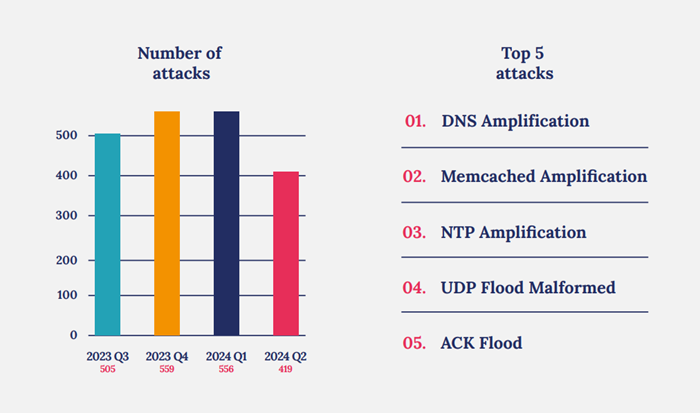Carding Forum
Professional
- Messages
- 2,788
- Reaction score
- 1,231
- Points
- 113
Despite the decrease in the number of attacks, their power is growing, reaching record levels.
The National Filtering Center in the Netherlands (NaWas), which protects its participants from DDoS attacks, recorded a significant decrease in the number of attacks in the second quarter of this year. In the period from April to June, the center processed 419 attacks, which is significantly less compared to 556 attacks in the previous quarter. The data is published by the Netherlands Institute for Information Security (NBIP).
According to historical data, this trend is quite consistent with seasonal fluctuations: in the first months of the year, the number of attacks is usually higher than in the second quarter.
However, despite the overall decrease in the number of attacks, the reporting period saw a sharp increase in the number of large-scale attacks exceeding 100 Gbit/s. The most powerful of them reached 353 Gbit/s. The most common types of attacks were DNS Amplification, Memcached Amplification, NTP Amplification, UDP flood, and ACK flood.

Attack statistics
The greatest threat, as before, is represented by complex and aggressive attacks from hacktivist groups, which, operating within the framework of various conflicts, most often target government agencies and healthcare institutions.
Particularly worrisome is the growing number of attacks targeting critical network infrastructure. Such attacks use the Time-To-Live (TTL) mechanism, which allows overloading network equipment and disabling it.
It is noteworthy that before the European Parliament elections, hacktivists announced an increase in the frequency of such attacks in their Telegram messages. Although the situation is currently relatively calm, NaWas experts emphasize the importance of constant vigilance.
Source
The National Filtering Center in the Netherlands (NaWas), which protects its participants from DDoS attacks, recorded a significant decrease in the number of attacks in the second quarter of this year. In the period from April to June, the center processed 419 attacks, which is significantly less compared to 556 attacks in the previous quarter. The data is published by the Netherlands Institute for Information Security (NBIP).
According to historical data, this trend is quite consistent with seasonal fluctuations: in the first months of the year, the number of attacks is usually higher than in the second quarter.
However, despite the overall decrease in the number of attacks, the reporting period saw a sharp increase in the number of large-scale attacks exceeding 100 Gbit/s. The most powerful of them reached 353 Gbit/s. The most common types of attacks were DNS Amplification, Memcached Amplification, NTP Amplification, UDP flood, and ACK flood.

Attack statistics
The greatest threat, as before, is represented by complex and aggressive attacks from hacktivist groups, which, operating within the framework of various conflicts, most often target government agencies and healthcare institutions.
Particularly worrisome is the growing number of attacks targeting critical network infrastructure. Such attacks use the Time-To-Live (TTL) mechanism, which allows overloading network equipment and disabling it.
It is noteworthy that before the European Parliament elections, hacktivists announced an increase in the frequency of such attacks in their Telegram messages. Although the situation is currently relatively calm, NaWas experts emphasize the importance of constant vigilance.
Source
